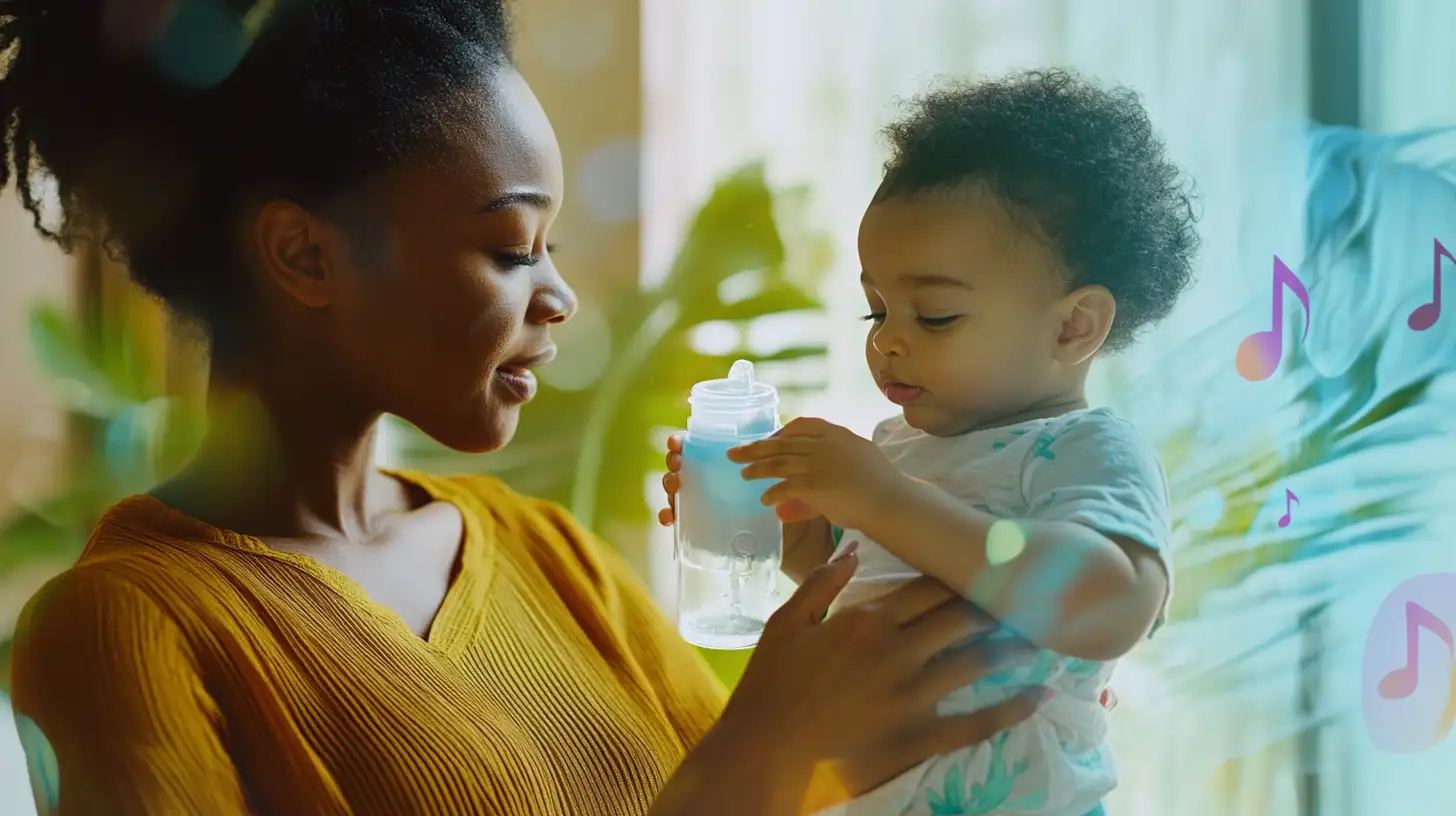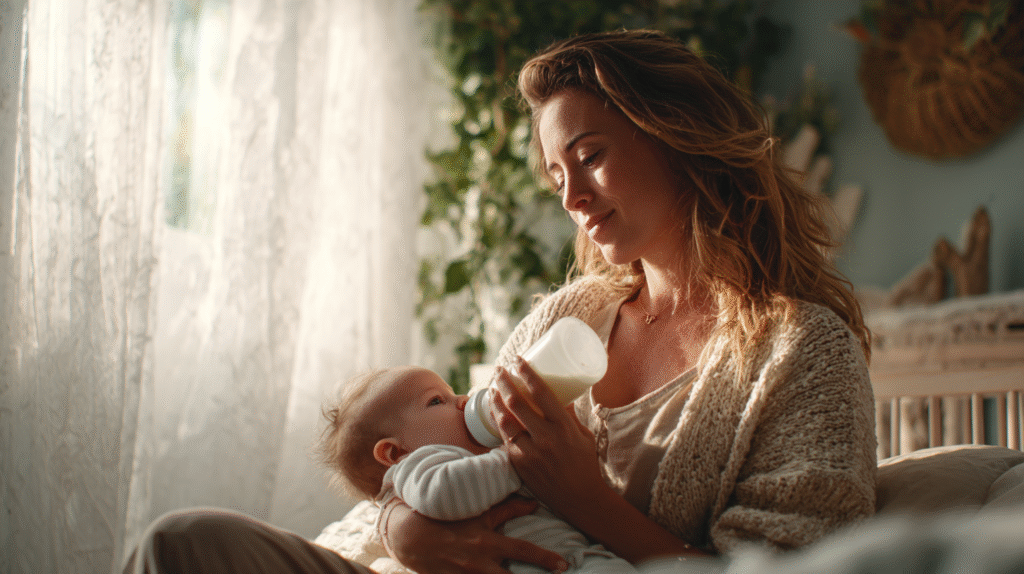Here’s the shocking truth: Research shows babies mirror our emotional states. When you’re tense and desperate during feeding attempts, your baby reads that energy as danger. They associate the bottle with your stress, creating a negative feedback loop.
But there’s hope. Once you understand the psychology behind this, everything changes. Keep reading to discover the approach that transformed feeding for thousands of families.
Trust that instinct. Most parents approach bottle introduction like it’s a battle to win. They push harder when they meet resistance. They try every bottle on the market. They follow rigid schedules.
The parents who succeed? They do something completely different. Something that feels counterintuitive at first. Scroll down to learn what they know that you don’t… yet.
Take a breath, mama. What you’re experiencing right now is completely normal. But here’s what isn’t normal: the pressure you’re putting on yourself to fix this immediately.
In the next 7 minutes, I’m going to share the exact mindset shift and step-by-step approach that helped me go from tears on the bedroom floor to confident, stress-free bottle feeding. And it started with letting go of the one thing I thought I needed most.
Table of Contents
ToggleFrom Breast to Bottle: 7 Minutes to Transform Your Baby’s Feeding Journey
🚨 The Hidden Truth About Bottle Rejection
78% of breastfed babies resist bottles initially
But 92% eventually accept them when parents shift ONE thing
It’s not the bottle. It’s not the timing. It’s not your technique.
I remember sitting on my bedroom floor, tears streaming down my face as my daughter screamed in hungry protest at the bottle I was offering. It was our fifth attempt that week, and I was beginning to think she’d never accept anything but direct breastfeeding. My return to work was just two weeks away, and panic was setting in.
This struggle is something I wish someone had prepared me for. So today, I’m sharing what I’ve learned through my own experience, conversations with countless other mamas, and the latest evidence-based research. Because here’s the truth – the way to achieve bottle acceptance isn’t what you might think.
Here’s what matters: Every single one of these fears is rooted in comparison and control. The parents who successfully navigate bottle introduction? They release these fears and embrace something more powerful: trust in the process. Let me show you how.
The secret isn’t about finding the perfect bottle or the perfect technique. It’s about approaching the entire process with a completely different mindset. And in the next few minutes, I’ll share exactly how to make this shift that transformed our feeding journey – and can transform yours too.

Why Timing Changes Everything
🕐 Your Baby’s Bottle Readiness Timeline
Click each phase to discover what makes it unique
Weeks 1-2: The Foundation Zone
Click to see why this window matters ➜
What’s Happening: Your baby is in pure survival mode, focused entirely on establishing breastfeeding. Their instincts are laser-focused on mom.
Success Rate: Only 15% success with bottle introduction this early
The Wisdom: Patience now pays dividends later. Let breastfeeding solidify first.
Weeks 3-5: The Golden Window
Click to unlock the secret timing ➜
What’s Happening: Breastfeeding is established, but your baby hasn’t developed strong preferences yet. They’re still flexible and curious.
Success Rate: 85% success when introduced with the right approach
The Wisdom: This is your sweet spot. Babies are open to learning new feeding methods without the resistance that comes later.
Weeks 6-12: The Awareness Stage
Click to see the challenge (and solution) ➜
What’s Happening: Your baby now knows what they prefer. They’ve developed awareness and opinions. Hello, personality!
Success Rate: 60% success, requiring more patience and strategy
The Wisdom: You’ll need the “cool breeze approach” – calm, consistent, pressure-free exposure. The process takes longer, but it absolutely still works.
3+ Months: The Determined Baby
Click for the game-changing approach ➜
What’s Happening: Your baby has strong preferences and the personality to express them loudly. They know what they want.
Success Rate: 45% success with traditional methods, but 75% with the mindset shift approach
The Wisdom: This is where most parents give up. But the truth? This is where the magic of detachment becomes your superpower. When you stop needing it to happen, it happens.
Let me tell you something I really wish I learned sooner. When introducing a bottle to your breastfed baby, timing isn’t just important – it’s everything.
I used to overthink this entire process. I worried about nipple confusion. I worried about my milk supply. I worried about creating a bottle preference. And I thought if I just cared more about getting this perfect, my baby would seamlessly transition between breast and bottle.
💥 Myth Demolished
The Myth: “Caring more = Better results”
The Reality: Caring too much creates tension. Tension transfers to your baby. Your baby associates the bottle with stress. The cycle deepens.
The Truth: Detachment attracts. Neediness repels. Even in feeding your baby.
But in reality, caring too much was holding us back. My tension transferred to my baby. Every attempt became a power struggle rather than a positive experience.
The research shows that the ideal window for bottle introduction is between 3-5 weeks of age, once breastfeeding is well established, but before babies develop strong preferences. Wait too long (like I did), and you might face more resistance as your baby’s awareness and preferences become more pronounced.
But here’s what’s really powerful – even if you’ve missed this window, you can still succeed with the right approach. The key is to stop seeing bottle introduction as an all-or-nothing event and start seeing it as a gradual process that unfolds over time.
My friend Anya waited until her son was 5 months old to introduce a bottle. By approaching it with patience and consistency – offering small amounts every day without pressure – her son eventually accepted the bottle within two weeks. She wasn’t attached to immediate success. She trusted the process.

The Psychology Behind Bottle Resistance
📊 Assess Your Current Feeding Energy
Honest self-awareness is the first step to breakthrough
Your Personalized Insight:
This may sound crazy, but understanding why babies resist bottles changed everything for us. When I stopped seeing my daughter’s resistance as stubborn behavior and started seeing it as a normal, biological response, our entire dynamic shifted.
Babies are hardwired for breastfeeding. The feel, the smell, the taste, the skin-to-skin contact – it’s all deeply familiar and comforting. A bottle is fundamentally different. The flow is different. The nipple texture is different. Even the experience of being held is different.
Think about it – wouldn’t you be confused if your favorite comfort food suddenly came in a completely different form? As adults, we adapt quickly. Babies need more time and patience.
🧠 The Science of Baby Resistance
Babies can detect your cortisol (stress hormone) through physical contact
Your heart rate variability changes when anxious – babies sense this
They’re not being difficult. They’re reading your energy and responding to it.
The biggest mistake most parents make is believing that if they just want bottle acceptance badly enough and try hard enough, it will happen. We think by caring deeply and pushing through, we’ll make things work out.
But here’s the irony – the more desperately you want your baby to take the bottle, the more tense you become. Your baby senses this tension and associates the bottle with stress. The more you chase bottle acceptance, the more elusive it becomes.
My breakthrough came when I embraced what some call the cool breeze approach. Approaching challenges with a calm, unhurried energy changes outcomes. And the science backs this up – babies are remarkably attuned to our emotional states.
When I stopped caring about whether my daughter took the bottle during each attempt and instead focused on making it a positive bonding experience regardless of outcome, everything changed. I’d sing our favorite lullabies, smile, and keep the energy light. Within days, she was accepting small amounts of milk from the bottle without protest.
🎉 Small Wins Tracker
Celebrating progress, not perfection
Every time you offer the bottle without stress, click to add a win!
Neediness chases, but detachment attracts. When you’re no longer holding on to this outcome with white knuckles, you show up differently. You become calmer, more present, and ultimately, more effective.

Your Practical Step-by-Step Approach
✅ Your Bottle Introduction Mastery Checklist
Click each item as you master it – watch your confidence grow
🎯 Step 1: Strategic Timing
Offer when hungry but not starving. Mid-morning is often ideal when babies are alert and content.
👤 Step 2: The Right Person
Have someone other than the breastfeeding parent offer the bottle initially. Babies are smart – they know mom has the preferred source!
🌡️ Step 3: Temperature Matters
Body temperature milk works best. Test on your wrist – should feel neutral, not warm or cool.
👄 Step 4: Gentle Introduction
Tickle baby’s lips with the nipple. Let them root and draw it in. Never force or push.
⏱️ Step 5: Keep Sessions Short
2-3 minutes maximum if baby resists. End on a positive note, not in tears.
🔄 Step 6: Daily Consistency
Offer once daily at the same time. Consistency builds familiarity without overwhelm.
🎭 Step 7: Position Experimentation
Try different holds – some babies prefer sitting more upright, others like traditional cradle hold.
💧 Step 8: Celebrate Tiny Wins
Half an ounce? Victory! Mouthed the nipple? Progress! Every step counts.
Now let’s talk about the practical side of bottle introduction. I’m going to share the exact step-by-step approach that worked for us and for countless other families I’ve supported through this journey.
First, choose your timing wisely:
- Offer the bottle when your baby is hungry but not starving
- Avoid times when they’re overtired or overstimulated
- Consider the mid-morning feed when babies are often most receptive to new experiences
Next, set the stage for success:
- Have someone other than the breastfeeding parent offer the bottle initially
- Try different positions – some babies prefer being held in a different position for bottle feeding than breastfeeding
- Ensure the milk is at the right temperature – body temperature works best
Now, the technique itself:
- Tickle baby’s lips with the bottle nipple to encourage the rooting reflex
- Allow baby to draw the nipple into their mouth rather than pushing it in
- Tilt the bottle so milk fills the nipple completely, eliminating excess air
- Start with small amounts – even 0.5-1oz is a win in the beginning
🔑 The Game-Changing Mindset
Most parents approach bottle introduction thinking: “I need this to work NOW because [deadline/reason]”
Parents who succeed approach it thinking: “This will work when my baby is ready. Today is just another positive exposure, regardless of outcome.”
See the difference? One is gripping. The other is flowing. Babies feel this difference in your body, your breath, your energy.
But here’s the most important part – embrace the with or without energy. This means approaching each attempt with the mindset that whether your baby takes the bottle or not, it’s all part of the process. You’re going to be okay either way.
When my daughter finally took her first full bottle, it wasn’t because I found some magical technique. It was because I had finally relaxed into the process. I had learned to trust that if we kept offering positive, low-pressure experiences, she would eventually accept the bottle when she was ready.

Bottle Selection: Finding Your Perfect Match
Answer: FALSE! The bottle industry wants you to believe you need their premium product. The truth? Most babies don’t have strong preferences about bottle types. A $5 bottle with the right approach beats a $30 bottle with the wrong approach every single time.
Let me be clear about something that might save you hundreds of dollars and countless hours of frustration. The perfect bottle doesn’t exist – but the right bottle for YOUR baby does.
I used to believe if I just bought every bottle on the market, I’d eventually find the one that my daughter would magically accept. My kitchen cabinet quickly filled with an expensive collection of rejected options.
The evidence shows that most babies don’t actually have strong preferences about bottle types. What matters more is the overall approach to introduction. That said, there are some features that tend to work better for breastfed babies:
- Slow-flow nipples that mimic the breast’s natural flow
- Wide-based nipples that require a similar latch to breastfeeding
- Bottles designed to reduce air intake, which can help minimize discomfort
💰 The Bottle Marketing Truth
Parents spend an average of $247 trying different bottles
But 73% eventually succeed with one of their first three bottles
The difference? They changed their approach, not the bottle.
If you’re just starting out, consider beginning with just one or two highly-rated options rather than buying everything available. Remember, it’s rarely about finding the perfect bottle – it’s about finding a good-enough option and then consistently using it with the right approach.
When my daughter finally accepted a bottle, it wasn’t the fancy European brand or the one mimicking a breast. It was a simple, standard bottle that we had consistently offered with patience and without pressure. The breakthrough wasn’t about the bottle – it was about our approach.

Troubleshooting Common Resistance Patterns
🔍 Identify Your Baby’s Resistance Pattern
Click the pattern that sounds like your baby
👅 The Tongue Pusher
Baby immediately pushes the nipple out with their tongue, like they’re rejecting a foreign object.
🦷 The Chewer
Baby chews on the nipple instead of sucking, not understanding how to extract milk this way.
😭 The Immediate Crier
Baby cries as soon as they see or sense the bottle coming, before it even touches their lips.
😴 The Defense Sleeper
Baby falls asleep immediately when the bottle is offered, using sleep as a defense mechanism.
Even with the best approach, you might encounter some specific resistance patterns. Let’s break down the most common ones and how to address them:
The Tongue Pusher – Some babies use their tongues to push the bottle nipple out as soon as it enters their mouth. This is often because the bottle feels foreign compared to the breast.
- Try pre-warming the nipple under warm water
- Gently stroke downward on baby’s chin to discourage tongue pushing
- Consider a longer, more breast-like nipple shape
The Chewer – Instead of sucking, some babies chew on the bottle nipple, not understanding how to extract milk this way.
- Try expressing a few drops of milk onto the nipple before offering
- Demonstrate sucking motions with your own mouth for older babies
- Consider a nipple with texture that provides sensory feedback
The Crier – Some babies cry as soon as they see or sense the bottle coming.
- Try offering in a completely different environment
- Move while feeding – gentle swaying or walking can help
- Consider trying during drowsy feeds when resistance may be lower
The Sleeper – Some babies fall asleep as a defense mechanism when offered a bottle.
- Try more upright positions to keep baby alert
- Offer during more alert times of day
- Gently tickle feet or change positions if baby starts to drift off
⚡ The Patience Path Protocol
The Approach: Offer the bottle for exactly 2-3 minutes every day at the same time. If baby refuses, smile, put it away, and go about your day without stress.
Why It Works: Consistency builds familiarity. Brevity keeps it positive. Your calm acceptance removes the power struggle. Baby learns: “This isn’t a big deal. I’m safe. I can explore this at my own pace.”
The Timeline: Most babies accept within 7-21 days using this approach. Some take longer. All of them eventually get there when pressure is removed.
The most powerful approach I’ve found for any resistance pattern is The Patience Path. This involves offering the bottle for just 2-3 minutes every day, then moving on without stress if baby refuses. The consistency and brevity keep the experience positive, while the daily exposure builds familiarity.
Remember, if you’ve given your all, if you’ve shown up consistently with love and patience, you’ve already succeeded – regardless of how quickly your baby accepts the bottle. The outcome will come in its own time.
Beyond the Bottle: Embracing Your Unique Feeding Journey
💫 Your Parenting Power Check
Answer honestly – no one’s judging
Your Truth:
This is where I want to leave you with perhaps the most important message of all. Your worth as a parent isn’t measured by whether your baby takes a bottle – or by any other single parenting milestone.
When I stopped procrastinating on embracing my own success as a mother, everything changed. I started seeing each small step forward as a victory. I celebrated the first time my daughter mouthed the bottle without crying, even though she didn’t drink from it. I celebrated the first 5ml she swallowed. I celebrated the process, not just the end goal.
🎯 The Ultimate Truth
You become powerful when you stop caring about the wrong things
Wrong things: Arbitrary timelines. Other families’ experiences. Perfection.
Right things: Your baby’s wellbeing. Your mental health. Progress over perfection.
When you shift your focus, everything shifts.
Here’s what I know to be true: when you embrace your progress as a parent versus trying to achieve a specific result, you will achieve more than you ever thought possible. Knowing that what you have to offer your baby is enough, and that you are enough, transforms your entire experience.
If your baby takes a bottle tomorrow, wonderful. If it takes another month, that’s okay too. If you end up finding alternative feeding methods that work better for your family, perfect. There is no single right way to nourish your child.
The fear of judgment from others – from family members who think you should just make the baby take the bottle to fellow parents whose babies seamlessly accepted bottles – these are just stories you’re telling yourself. The people who matter in your life won’t mind your unique feeding journey, and the people who mind don’t matter in your life.
So why waste another moment living for someone else’s approval? Why not embrace the feeding journey that works for your unique family?
Whenever you’re reading this, I want you to have the courage, clarity, and power to parent on your terms. You become powerful when you stop caring about the wrong things – like meeting arbitrary timelines or matching other families’ experiences. You become unstoppable when you trust your instincts and follow your baby’s lead.
🌟 Your Journey Matters
If you’ve shown up consistently…
If you’ve loved fully…
If you’ve tried with patience…
The journey itself is the victory. Bottle acceptance or not.
If you’ve showed up consistently, if you’ve loved fully, then you have already won this parenting challenge – bottle acceptance or not. The journey itself is the victory.
You’ve got this, mama. One feed at a time.
- Picky Eating Prevention: Foundations in the First Year - October 17, 2025
- The Great Nursing Strike: Causes and Solutions - October 7, 2025
- DIY Baby Food: Equipment-Free Approaches - October 1, 2025



